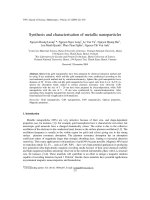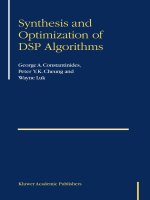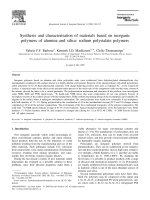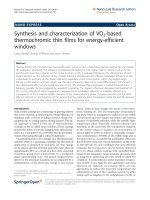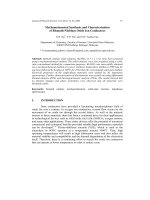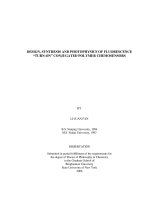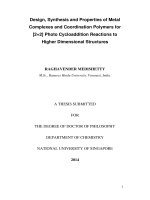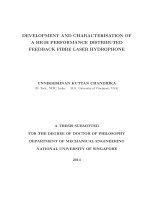synthesis and characterisation of materials based on inorganic
Bạn đang xem bản rút gọn của tài liệu. Xem và tải ngay bản đầy đủ của tài liệu tại đây (575.8 KB, 9 trang )
International Journal of Inorganic Materials 2 (2000) 309–317
Synthesis and characterisation of materials based on inorganic
polymers of alumina and silica: sodium polysialate polymers
ab,a
*
Valeria F.F. Barbosa , Kenneth J.D. MacKenzie , Clelio Thaumaturgo
a
Departamento de Ciencia dos Materiais
,
Instituto Militar de Engenharia
,
Praca General Tiburcio
,80
Praia Vermelha
,
Rio de Janeiro
,
CEP
22 290 270,
Brazil
b
New Zealand Institute for Industrial Research and Development
,
P
.
O
.
Box
31
-
310,
Lower Hutt
,
New Zealand
Accepted 8 May 2000
Abstract
Inorganic polymers based on alumina and silica polysialate units were synthesised from dehydroxylated aluminosilicate clay
(metakaolinite) condensed with sodium silicate in a highly alkaline environment. Reaction of the aluminosilicate with alkali polysilicates
1
yields polymeric Si–O–Al three-dimensional structures with charge-balancing positive ions such as hydrated Na in the framework
cavities. A statistical study of the effect on the polymerisation process of the molar ratio of the component oxides and the water content of
the mixture showed the latter to be a critical parameter. The polymerisation mechanism and structures of the products were investigated
29
using NMR, XRD and FTIR spectroscopy. Si liquid-state NMR shows that some compositions do not cure properly because of
incomplete reaction of the sodium silicate with the metakaolinite. FTIR confirms that during drying of the incompletely cured samples, Na
migrates to the surface where it undergoes atmospheric carbonation. The cured polymers were found to be essentially X-ray amorphous,
with bulk densities of 1.3–1.9. During polymerisation the coordination of Al in the metakaolinite reactant (IV, V and VI) changes almost
completely to IV in all the polymer compositions. The environment of the Na is unchanged irrespective of the polymer composition. The
29
solid-state Si NMR spectra indicate a range of Si–O–Al environments. Typical mechanical properties of the best polymers were: Mohs
hardness .7, Vickers hardness about 54, and compressive strength (after drying for 1 h at 658C) 48.1 MPa. 2000 Elsevier Science
Ltd. All rights reserved.
Keywords
:
A. inorganic compounds; A. polymers; B. chemical synthesis; C. infrared spectroscopy; C. nuclear magnetic resonance (NMR)
1. Introduction viable alternative for many conventional cements and
plastics [1–10]. The manufacture of polysialates does not
New inorganic materials which could increasingly re- create CO emissions, they can be made from recycled
2
place conventional cements, plastics and many mineral- mineral wastes, and they provide a heat-resistant substitute
based products hold the key to the reduction of world for flammable organic materials.
pollution resulting from the manufacturing and use of the Polysialates are inorganic polymers derived from
older materials. Such pollutants include CO emissions aluminosilicates. They can be synthesised at low tempera-
2
from cement kilns, toxic metal contamination of freshwater ture and have useful properties such as high early compres-
resources resulting from mining operations, and catas- sive strength, a Mohs hardness of 4–7, and they are stable
trophic fires involving common organic plastics. at temperatures up to 1300–14008C. By changing the
During the last decade a family of new materials called Si/Al ratio, it is possible to produce products with a range
polysialates has emerged as a possible solution to these of physical and mechanical properties [1–5]. Polysialates
problems, since their physical properties make them a are readily synthesised from natural aluminosilicates such
as kaolinite, which is one of the most abundant sources of
alumina and silica.
*Corresponding author. Present address: Department of Materials,
Several fundamental polysialate units have been iden-
University of Oxford, Oxford OX1 3PH, UK. Tel.: 144-1865-273-700;
tified [3]; polymers may be composed of the sialate unit
fax: 144-1865-273-789.
[–Si–O–Al–O–] (designated PS when polymerised), sial-
E-mail address
:
(K.J.D. Mac-
Kenzie). ate siloxo units [–Si–O–Al–O–Si–O–] (designated PSS
1466-6049/00/$ – see front matter 2000 Elsevier Science Ltd. All rights reserved.
PII: S1466-6049(00)00041-6
310 V
.
F
.
F
.
Barbosa et al
.
/ International Journal of Inorganic Materials
2 (2000) 309
–
317
when polymerised) or sialate disiloxo units [–Si–O–Al– was typical for kaolinite, showing endothermic dehydrox-
O–Si–O–Si–O–] (designated PSDS when polymerised). ylation at 500–7008C and sharp exotherms at 9988C and
In all the polymerised structures, the Al is four-coordi- 12508C, the latter corresponding to the formation of
nated, creating a negative charge imbalance which is secondary mullite [12].
compensated for by the presence of monovalent cations A series of seven Na–PSS polymer compositions were
11
such as Na or K . Some of the details of polysialate determined statistically from the Taguchi Tables for the
formation and technology are still not fully understood. following range of molar oxide ratios [13]: 0.2,Na O/
2
The purpose of this work is to elucidate aspects of the SiO ,0.48, 3.3,SiO /Al O ,4.5, 10,H O/Na O,25.
222322
polymerisation mechanism and structure of products based The seven polymer compositions, designated Na–PSS1
1
on polysialate siloxo (PSS) units containing Na . For this to Na–PSS7, are shown in Table 2.
purpose, a number of compositions of various oxide molar The polymer components were mixed in the correct
ratios were selected statistically. The mixtures were then proportions, placed in cylindrical plastic moulds, allowed
polymerised and cured at both 658C and room temperature. to mature at room temperature for 60 min, cured at 658C
A structural study of Na–PSS polymer was made on an for 90 min and dried at 658C for 60 min. During the curing
anhydrous sample which had been maintained at 658C until stage, the water, which is essential for polymerisation, was
no further mass loss was detected. The synthesis and retained by sealing the top of the mould with thin
27 29
structure of Na–PSS polymer was studied by Al, Si and polyethylene film. Parallel preparations of Na–PSS1 and
23
Na solid-state nuclear magnetic resonance with magic- Na–PSS7 were also made using room-temperature curing
angle spinning (MAS NMR), Fourier transform infrared and drying. In this case, the rate of water evaporation was
spectroscopy (FTIR), and X-ray powder diffraction sufficiently low to eliminate the need for the polyethylene
(XRD). film and the mixture remained in the mould for about 15 h.
The pH of the polymer mixtures, determined using an
Orion PerpHect Model 310 pH meter, was about 13.9.
2. Experimental Changes in the viscosity of the mixtures with time were
monitored at room temperature using a Krebs–Stormer
The polymers were synthesised from metakaolinite, viscometer (Arthur H. Thomas). The polymerisation pro-
prepared by heating kaolinite from Northeast Brazil at cess was also monitored by measuring the liquid-phase
29
7008C for 6 h [11]. The chemical compositions of the 11.7T Si NMR spectra at intervals during the reaction
starting materials are presented in Table 1. The other using a Varian Unity 500 spectrometer and a 10-mm
reactants were sodium silicate (Gessy Lever) (Table 1) and liquids probe with a 15 ms908 pulse and a recycle delay of
sodium hydroxide pellets (Grade P.A., Vetec). 1 s. The spectra were referenced to tetramethylsilane
The particle size distributions, measured using a Sedig- (TMS) in CDCl .
3
raph 5100, were: kaolinite, 41%,2 mm, median ESD 2.59 After drying, the Mohs and Vickers hardness figures of
mm, metakaolinite, 11.9% ,2 mm, median ESD 4.24 mm. the materials were measured and the compressive crushing
The densities of the kaolinite and metakaolinite, deter- strength was determined using a 100-ton testing machine
mined using a Le Chatelier volumetric vessel to the ABNT (Alfred J. Amster).
21
NBR 6474 standard, were 2.51 and 2.32 g cc , respec- Powdered samples of the cured and dried polymers were
tively. The DTA trace of the kaolinite, from which the studied using the following techniques:
dehydroxylation conditions were determined, was obtained
up to 15008C in flowing Ar using a Perkin Elmer ther- • Powder X-ray diffraction (XRD), using a Philips PW
21
moanalyser at a heating rate of 208 min . The DTA trace 1700 computer-controlled goniometer with a graphite
monochromator and CoKa radiation.
27 29 23
• Al, Si and Na MAS NMR at 11.7 T using a
Table 1
Varian Unity 500 spectrometer and a 5-mm Doty
Chemical composition of the starting materials
Component (%) Kaolinite Sodium silicate
Table 2
Al O 39.8 –
23
Polymer compositions of this study
SiO 44.4 35.6
2
K O 0.33 –
2
Sample SiO /Al O Na O/SiO H O/Na O
223 2 2 2 2
Na O 0.04 17.3
2
Na–PSS1 3.3 0.25 10
CaO ,0.01 –
Na–PSS2 3.3 0.25 25
MgO 0.01 –
Na–PSS3 3.3 0.45 10
Fe O 0.30 –
23
Na–PSS4 3.3 0.45 25
TiO 0.11 –
2
a
Na–PSS5 4.5 0.33 10
LOI (%) 14.4 –
Na–PSS6 4.5 0.33 25
H O (%) – 44.3
2
Na–PSS7 3.8 0.30 17.5
a
Ignition loss at 9508C.
V
.
F
.
F
.
Barbosa et al
.
/ International Journal of Inorganic Materials
2 (2000) 309
–
317
311
27
Table 3
MAS probe spun at 10–12 kHz. The Al spectra
Compressive strengths (MPa) of Na–PSS polymers after different ageing
were acquired at 130.244 MHz using a
p
/10 pulse
times
for solution and a recycle delay of 1 s, the spectra
a
31 29
Sample 1 h strength 24 h strength 3 day strength
referenced to Al(H O) . The Si spectra were
26
acquired at 99.296 MHz using a 6-ms(
p
/2) pulse Na–PSS1 48 52 49
Na–PSS3 41 19 25
with a 10 s recycle delay, the spectra referenced to
23
Na–PSS5 28 28 30
tetramethylsilane (TMS). The Na spectra were
Na–PSS7 1 3 8
acquired at 132.225 MHz using a 1-ms
p
/10 pulse
a
Samples Na–PSS2, Na–PSS4 and Na–PSS6 did not dry and cure
for solution with a recycle delay of 1 s, the spectra
under the present conditions. Even after curing for 24 h at 658C they were
referenced to 1 M aqueous NaCl.
too soft to permit mechanical strength measurements.
• Fourier transform infrared spectroscopy was carried
out on samples suspended in KBr discs using a
Perkin-Elmer 2000 FTIR spectrometer. the higher water contents (Na–PSS2, Na–PSS4 and Na–
PSS6) requiring almost 24 h at 658C to cure. Furthermore,
the mechanical properties (compressive strength and hard-
3. Results and discussion ness) of these slow-curing samples were too poor to permit
their measurement. Table 3 shows the compressive
3.1.
Polymerisation behaviour of the various sample strengths of the samples which did cure. Sample Na–PSS1
compositions showed the optimum behaviour, attaining a high compres-
Considerable differences were observed in the poly-
merisation behaviour of the various samples, those with
29
Fig. 2. Liquid-state Si NMR spectra of: (A) sodium silicate; (B) sodium
Fig. 1. (A) Viscosity of Na–PSS1 as a function of elapsed time after
silicate1NaOH; (C) polymer composition Na–PSS1 immediately after
mixing. (B) Log–log plot of the above data.
mixing.
312 V
.
F
.
F
.
Barbosa et al
.
/ International Journal of Inorganic Materials
2 (2000) 309
–
317
sive strength (48 MPa) in 1 h. The other properties of this present purpose is to monitor changes in viscosity during
best material were: bulk density 1.40860.002, apparent polymerisation, it was not calibrated for absolute vis-
porosity 36.66260.146, Mohs hardness .7, and Vickers cosities. The change in viscosity with elapsed time after
hardness about 54. Although the next best composition, mixing the polymer components [Fig. 1(A)] shows a
sample Na–PSS3, attained a reasonable compressive change in slope after about 40 min reaction. When plotted
strength after 1 h, this was not maintained, and decreased on a log–log scale [Fig. 1(B)], this behaviour is quali-
to about half its initial value over the next 24 h. Sample tatively similar to the well-known relationship between the
Na–PSS7, containing slightly higher ratios of Na O/SiO melt viscosity and molecular weight of a polymer [15] and
22
and H O/Na O than Na–PSS1, developed its mechanical confirms that a polymerisation reaction is occurring in
22
properties extremely slowly taking 3 days to achieve a which the average molecular weight is increasing with
compressive strength of 8 MPa, bulk density of 1.314, time. In the early stage, below the break point, the growing
apparent porosity of 33.886 and Mohs hardness of 3–4. units behave as a dilute solution in the unreacted mixture,
These results indicate a critical dependence of the poly- but as the polymer concentration increases, the units move
merisation process on the initial composition of the closer together and overlap, initiating a rapid increase in
mixture, particularly with respect to the water content. the number of polymer linkages and average molecular
weight. The viscosity behaviour of the present system is
3.2.
Polymerisation mechanism thus similar to the ‘gel effect’ which occurs during radical
polymerisation [16].
The change in viscosity during the polymerisation of a In an attempt to determine the critical differences
mixture of optimum composition (Na–PSS1) is shown in between good and poorly curing compositions, liquid-state
Fig. 1. NMR was carried out on mixtures Na–PSS1, Na–PSS2
The Krebs–Stormer viscometer used here is of the shear (with the same oxide molecular ratio as Na–PSS1 but
type in which the rotational motion is applied using a higher water content and did not set) and Na–PSS7 (higher
29
paddle wheel rather than concentric cylinders. Although it Na content and poorer mechanical properties). The Si
is normally used for commercial process control, providing NMR liquid spectrum of the initial sodium silicate [Fig.
012 3
viscosity values expressed in arbitrary units, it may be 2(A)] shows the sharp peaks of the Q , Q , Q and Q sites
calibrated with solutions of known viscosity [14]. Since its at about 272, 280, 287 and 296 ppm, respectively [17],
29
Fig. 3. Liquid-state Si NMR spectra of polymer mixtures recorded at the indicated elapsed times (minutes) after mixing: (A) Na–PSS1; (B) Na–PSS2;
(C) Na–PSS7.
V
.
F
.
F
.
Barbosa et al
.
/ International Journal of Inorganic Materials
2 (2000) 309
–
317
313
together with a broad resonance at –110 ppm arising from mixing, indicating that the formation of the polymer by
the glass sample tube. After addition of the NaOH to the consumption of the sodium silicate is not proceeding. The
sodium silicate, the spectrum [Fig. 2(B)] is essentially FTIR results (see below) reveal the formation of sodium
unchanged, but the addition of the solid aluminous com- carbonate in the poorly cured samples Na–PSS2–Na–
ponent (metakaolinite) in proportions corresponding to PSS7, by atmospheric carbonation of the unreacted sodium
29
Na–PSS1 produces an immediate broadening of the Si silicate and/or sodium hydroxide. Sodium carbonate is not
spectrum and a shift in the peak positions to less shielded detected in the well-cured sample Na–PSS1, in which
values [Fig. 2(C)], suggesting an immediate reaction polymerisation has consumed the sodium silicate before it
between the sodium silicate and the solid aluminate. The can react with atmospheric CO . Although some initial
2
progress of the reaction in Na–PSS1, Na–PSS2 and Na– reaction seems to occur in the samples of higher water
29
PSS7 was monitored by acquiring their Si liquid NMR content, its comparatively slow progress may be hindered
spectra at intervals after mixing (Fig. 3). by the competing formation of sodium carbonate. Attempts
27
Fig. 3(A) shows that in the mixture Na–PSS1 the to detect the presence in these mixtures of a solution Al
intensity of the broadened but diagnostic sodium silicate NMR signal were not successful, indicating that the
resonances progressively decreases over the first 7 h of the reaction does not involve significant dissolution of Al from
reaction, as the silicate is consumed by the formation of the solid into the liquid phase.
29
the polymer. The Si spectrum remaining after the A selection of FTIR spectra of the starting metakaolinite
disappearance of the sodium silicate peaks consists of the and the various polymers is shown in Fig. 4.
original broad signal from the glass tube, with an extended The metakaolinite spectrum [Fig. 4(A)] is typical, with
21 21
downfield shoulder originating from the solidified polymer. broad bands at about 3450 cm and 1650 cm from
By contrast, the sequence of spectra of mixtures Na–PSS2 adsorbed atmospheric water, an Si–O stretching vibration
21 21
and Na–PSS7 [Figs. 3(B) and (C)] shows that although the at 1088 cm , an Si–O–Al vibration at 810 cm and an
silicate resonances are broadened by the addition of
metakaolinite, suggesting some initial interaction, their
intensities remain virtually unchanged up to 15 h after
Fig. 5. Typical XRD powder diffraction patterns of the starting materials
Fig. 4. FTIR spectra of metakaolinite and selected polymer compositions
and selected polymer compositions after curing and drying. Asterisks
after curing and drying.
mark the major reflection of quartz (PDF No. 33-1161).
314 V
.
F
.
F
.
Barbosa et al
.
/ International Journal of Inorganic Materials
2 (2000) 309
–
317
21
Si–O bending vibration at about 450 cm [18,19]. The typical diffraction pattern of a well-crystallised layer lattice
21
shoulder near 1000 cm arises from the quartz impurity. mineral (PDF No. 29-1488) with a quartz impurity (PDF
On the formation of the polymer, the following changes No. 33-1161), which remains as the major sharp diffrac-
in the spectra are noted: tion line after dehydroxylation [Fig. 5(B)]. The quartz
(a) The presence of the added water increases the impurity reflection is also retained in the XRD patterns of
21
intensity of the bands at about 3500 and 1650 cm . all the polymers, which show a similar amorphous charac-
(b) Major disruption of the Al environment is indicated ter, irrespective of whether they display good curing
21
by the loss of the Si–O–Al band at 810 cm which is behaviour [Fig. 5(C) and (D)] or remain poorly cured [Fig.
replaced by several weaker bands in the range 600–800 5(E)–(G)]. Likewise, there are no significant differences in
21
cm . Further information about the behaviour of the Al the XRD patterns of samples cured at room temperature
27
on polymerisation is provided by the Al MAS NMR data [Fig. 5(C)] and at 658C [Fig. 5(D)]. These X-ray data
(see below). suggest that irrespective of the development of good
(c) As referred to above, the presence of sodium mechanical properties, the structure of all the polymers is
21
carbonate is indicated by the band at about 1460 cm [20] typically glass-like, consisting of randomly developed Al–
in all the polymers except the well-cured sample Na–PSS1 Si polyhedra with a lack of periodically repeating atomic
[Fig. 4(B)], in which, however, the carbonate peak appears ordering.
when the solid polymer is dried for about 30 h to constant A selection of 11.7 T solid-state MAS NMR spectra of
weight after curing [Fig. 4(C)]. This interesting result the starting material (metakaolinite) and the various poly-
suggests that during prolonged drying of the cured polymer mers is shown in Fig. 6.
27
slab, the passage of water through the bulk carries with it a The Al spectrum of the initial metakaolinite [Fig.
high concentration of sodium to the surface, where it then 6(A)] is typical of this phase, showing broad overlapping
carbonates. resonances at 52 ppm (tetrahedral), 10 ppm (octahedral)
A selection of typical powder X-ray diffraction patterns and a resonance at 28 ppm which is often attributed to Al
of the starting materials and polymers of different com- in 5-fold coordination with oxygen [21]. When the metaka-
positions is shown in Fig. 5. olinite is mixed with the other polymer-forming con-
The kaolinite starting material [Fig. 5(A)] shows the stituents, the Al coordination immediately changes to
27
Fig. 6. 11.7 T solid-state MAS NMR spectra of the starting material and selected polymer compositions after curing and drying: (A)–(D) Al spectra;
29 23
(E)–(H) Si spectra; (I)–(L) Na spectra.
V
.
F
.
F
.
Barbosa et al
.
/ International Journal of Inorganic Materials
2 (2000) 309
–
317
315
29
predominantly tetrahedral [Fig. 6(B)–(D)] irrespective of The Si spectrum of the metakaolinite [Fig. 6(E)] is
whether the composition leads to well-cured [Fig. 6(B)] or typical [22], showing a broad band at about 2104 ppm
4
poorly cured materials [Fig. 6(C) and (D)]. Despite its attributable to the presence of the Q (1Al) structural unit,
appearance in all the polymer samples, the small amount of and a poorly resolved component at 295 ppm consistent
octahedral Al may merely indicate the presence of traces with the presence of residual silanol groups. All the
of residual metakaolinite rather than signalling an essential polymers show single broad resonances characteristic of
structural role for non-tetrahedral Al in the polymer. amorphous materials containing a range of slightly differ-
27
The Al spectra shown in Fig. 6 have been scaled to the ent environments [Fig. 6(F)–(H)]. The positions of the
same vertical height, masking considerable differences in broad polymer peaks are shifted downfield from that of the
the spectral intensities. As shown in Fig. 7, when plotted initial metakaolinite, with maxima situated in the region
27
on the same intensity scale, all the Al spectra are much characteristic of more highly Al-substituted units such as
44
weaker than that of the well-polymerised PSS1, having Q (2Al) or Q (3Al). The optimum composition Na–PSS1
integrated intensities ranging from 3.4 to 11% of PSS1, cured at 658C [Fig. 6(G)] shows a poorly resolved
even for samples of the same Al content as PSS1 (Fig. 7). shoulder at about 2106 ppm indicative of some free SiO ,
2
Since the Al is not physically lost from the solid system, but otherwise the shape and shifts of the spectra show no
having not been detected by solution NMR, the loss of Al systematic dependence on either their curing conditions or
signal from the less-well-polymerised samples is probably their composition. However, differences in the spectral
due to its occurrence in poorly ordered regions in which intensities were observed between the well-polymerised
the signal is broadened beyond detection. Such a phenom- PSS1 reacted at room temperature and the other samples,
27
enon particularly affects quadrupolar nuclei such as Al, in which the integrated intensities were about 60–75% of
27
and has been found to occur when a crystalline PSS1 (RT). As with the Al spectra, this effect is
aluminosilicate such as kaolinite is amorphized by thermal probably related to the superior polymerisation of PSS1,
27 27
dehydroxylation [22]. The greatly increased Al intensity although it is smaller than for Al, as would be expected
of sample PSS1 is a reflection of its more ordered for a non-quadrupolar nucleus. The lower intensity of
polymerised structure. sample PSS1 polymerised at 658C (74% of the intensity of
the sample polymerised at room temperature) is interesting;
this suggests that even when the composition is favourable
for polymerisation, a slower reaction results in a compara-
tively better organised structure.
23
The Na spectra of all the polymers typically show a
single resonance about 10 ppm wide at about 23.5 to 26
ppm, irrespective of composition or curing conditions [Fig.
23
6(I)–(L)]. The position of these Na resonances is as
found for the hydrated Na ion in hydrothermally altered
glass (27.7 ppm [23]) and for the interlayer Na of Na–
hectorite (25.3 ppm [24]). A small shoulder at about 5
ppm in the spectrum of Na–PSS2 [Fig. 6(K)] may arise
from a small amount of hydrated sodium aluminosilicate
23
[23]. A slight decrease in the Na spectral intensity was
observed in the well-polymerised sample PSS1 by com-
parison with the other samples, possibly reflecting the
removal by aqueous diffusion of the excess sodium not
utilised in polymer formation. The higher sodium content
of the poorly polymerised samples was shown by FTIR to
be involved in carbonate formation.
3.3.
Implications for the formation and structure of the
polymer
The present results indicate that the optimum formation
and curing of Na–PSS polymer occurs when the ratio
Na O:SiO is 0.25 and the ratio H O:Na O is 10. This
22 22
sodium content represents a sufficient amount to satisfy the
charge-balance requirements within the structure, without
27
providing an excess which can form sodium carbonate and
Fig. 7. 11.7 T Al MAS NMR spectra of several PSS polymer
may disrupt the polymerisation process. Reasons for the
compositions cured at 658C, plotted on the same intensity scale.
316 V
.
F
.
F
.
Barbosa et al
.
/ International Journal of Inorganic Materials
2 (2000) 309
–
317
critical dependence of polymerisation on the water content similar to glasses or hydrated silicate minerals in having a
are less obvious: it is clearly necessary to provide suffi- range of Si environments, but predominantly those of
cient water to facilitate mixing and provide a mechanism framework structures saturated in Al (e.g. SiQ (3Al)). The
4
for ionic transport. The effect of excess water may be to Al is essentially all in tetrahedral sites. A semi-schematic
dilute the reaction or to leach the more soluble components structural model which satisfies these requirements is
and transport them away from the reaction zone. shown in Fig. 8(A).
Irrespective of the curing and drying properties of a The structure contains Si and Al tetrahedra randomly
particular composition, all the polymer mixes studied here distributed along the polymeric chains which are cross-
showed a lack of long-range atomic order, with respect to linked so as to provide cavities of sufficient size to
29
their powder XRD diffractograms and Si MAS NMR accommodate the charge-balancing hydrated sodium ions.
spectra. In this respect they show structural characteristics This arrangement leads to Si environments such as
Fig. 8. (A) Proposed semi-schematic structure for Na–polysialate polymer. (B) Three-dimensional framework structure based on a suggested model for
K–polysialate polymer, after Davidovits [2]. ^, SiQ (3Al) site; *, SiQ (2Al) site; %, SiQ (1Al) site; [, AlQ (4Si) site.
44 4 4
V
.
F
.
F
.
Barbosa et al
.
/ International Journal of Inorganic Materials
2 (2000) 309
–
317
317
˜
`
Q (2Al) and Q (3Al), but with a predominance of the Fundac¸ao de Amparo a Pesquisa do Estado do Rio de
44
29
latter leading to the observed broad Si NMR resonance Janeiro (FAPERJ) for financial support. KJDM is indebted
envelope centred at about 292 ppm, but skewed towards to the Royal Society of New Zealand for a James Cook
higher fields (Fig. 6). All the Al atoms have Si nearest Research Fellowship under which part of this work was
neighbours. A more ordered structure has been suggested carried out.
[2] for the related potassium polysialate siloxo polymer,
from which an analogous sodium PSS structure can be
derived [Fig. 8(B)]. However, the structure in Fig. 8(A) is
preferred because its relatively greater disorder and its
References
ability to accommodate hydrated sodium ions is more
consistent with the present experimental data.
[1] Davidovits J, Davidovits M. Ceram Eng Sci Proc 1988;9:835.
[2] Davidovits J. J Mater Ed 1994;16:91.
[3] Davidovits J. Geopolymer 88, 1st Eur. Conf. Soft Mineralogy, vol.
1, 1988:25.
4. Conclusions
[4] Davidovits J. World Resource Review 1994;6:263.
[5] Davidovits J. Concrete Int 1994;16:53.
Reaction of metakaolinite with sodium silicate in a
[6] Silva FJ, Dias DP, Barbosa VFF, Oliveira MC, Thaumaturgo C. Proc
highly alkaline environment produces in mixtures with an
II Int Conf High-Performance Concrete and Performance and
Quality of Concrete Structures, Gramado, Brazil, 1999, in press.
Al:Si ratio of 1:2 an inorganic polymer which cures at
[7] Silva FJ, Barbosa VFF, Souza ANN, Thaumaturgo C. Acta Micro-
room temperature or 658C to a stable material with a
scopica, Proc 6th Brazilian Conf Microscopy of Materials/MICRO-
compressive crushing strength of 48.1 MPa, Mohs hard-
MAT 98, vol. 7A, 1998:137.
ness .7 and Vickers hardness of about 54. Optimum
[8] Van Jaarsveld JGS, Van Deventer JSJ. Miner Eng 1996;10:659.
curing and polymer properties are obtained when the Na
[9] Silva FJ, Barbosa VFF, Thaumaturgo C, Proc II Brazilian Regional
Conf Polymers, 1998, pp. 103.
concentration is sufficient to provide a charge-balancing
[10] Palomo A, Macias A, Blanco MT, Puertas F, Proc 9th Int Cong
mechanism for the substitution of tetrahedral Si by Al, but
Chem Cement, 1992, pp. 505.
not in sufficient excess to form sodium carbonate by
[11] Barbosa VFF, Thaumaturgo C, Proc Vi Encontro de Usuarios de
atmospheric carbonation. Polymer compositions which do
Ressonancia Magnetica Nuclear, Brazil, 1997, pp. 159.
not cure satisfactorily show FTIR evidence of carbonation,
[12] Grim RE. Clay mineralogy, 2nd ed., New York: McGraw-Hill, 1968.
by contrast with optimum curing compositions. The water [13] Davidovits J, US Patent No. 4,349,386, 1982.
[14] Geddes JA, Dawson DH. Ind Eng Chem 1942;34:163.
content of the mixture is also critical for satisfactory
[15] Boyd RH, Phillips PJ. In: The science of polymer molecules,
polymerisation.
Cambridge: Cambridge University Press, 1993, p. 20.
29
The cured polymers are X-ray amorphous and have Si
[16] Grosberg AYu, Khokhlov AR. Giant molecules, San Diego: Aca-
MAS NMR spectra consistent with three-dimensional
demic Press, 1997, chapter 9.11.
glassy structures in which the Si occurs in a variety of
[17] Engelhardt G, Michel D. In: High-resolution solid-state NMR of
silicates and zeolites, New York: Wiley, 1987, p. 77.
environments but with a predominance of Q (3Al) units.
4
[18] Parker RW, Frost RL. Clays Clay Mins 1996;44:32.
The Al is essentially all tetrahedral. A structural model is
[19] Frost RL, Frederick PM, Shurvell HF. Can J Appl Spectroscopy
proposed which satisfies these criteria.
1996;41:10.
[20] Gadsen JA. In: Infra-red spectra of minerals and related inorganic
compounds, London: Butterworth, 1975, p. 65.
Acknowledgements [21] Sanz J, Madani A, Serratosa JM, Moya JS, Aza S. J Amer Ceram
Soc 1988;71:C418.
[22] MacKenzie KJD, Brown IWM, Meinhold RH, Bowden ME. J Amer
We are indebted to R.L. Frost, Queensland University of
Ceram Soc 1985;68:293.
Technology, for the FTIR spectroscopy and to Centro de
[23] Yang W-HA, Kirkpatrick RJ. Geochim Cosmochim Acta
Tecnologia Mineral (CETEM) for the chemical analyses.
1989;53:805.
˜
VFFB and CT are grateful to Coordenac¸ao de Aper-
[24] MacKenzie KJD, Meinhold RH, Chakravorty AK, Dafadar MH. J
Mater Chem 1996;6:833.
´
feic¸oamento de Pessoal de Nıvel Superior (CAPES) and
